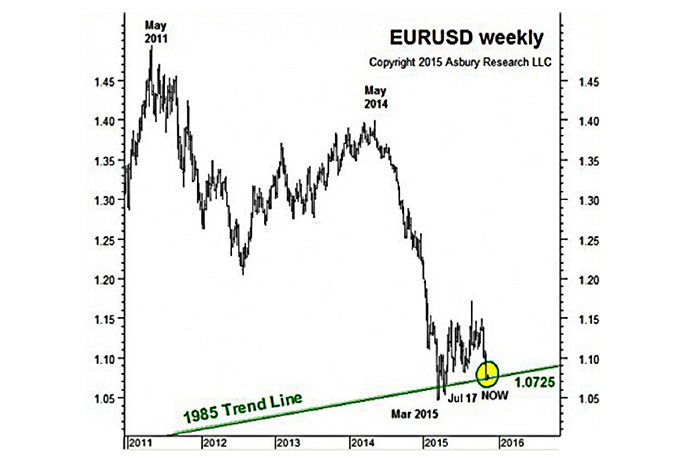
This major resistance level, which is the 1985 rising uptrend line in EURUSD, has already been tested three times since March, and the euro cannot seem to move off of it. Any further weakness in EURUSD that results in a sustained decline below 1.0725 would indicate that a major bullish trend change is underway in the greenback versus Europe.
Here are several keys to our analysis, in order of their importance:
1. Support/Resistance: Euro/U.S. dollar (EURUSD)
This relationship is at a major decision point, with indicators remaining bearish. The following figure shows that EURUSD begins this week right on top of secular support at its 1985 uptrend line at 1.0725. How this resolves will be a key indication of the U.S. currency’s next intermediate- to long-term trend versus Europe.
EURUSD HISTORICAL SUPPORT TREND

2. Chart Patterns: U.S. dollar/Japanese yen (USDJPY)
The USDJPY’s two failed attempts to break major overhead resistance at its 2007 benchmark high this summer evolved into a chart pattern—a double top—that continues to target an additional 6% decline. A move above 123.80 would clear the way for USDJPY to rise above the two “tops” and resume the previous dollar-bullish trend.
3. Investor Sentiment: U.S. dollar
Sentiment is turning near- and intermediate-term bearish for the dollar. The latest data suggest that the U.S. currency is within weeks of a one-to-several-month peak versus Europe.
4. Intermarket Relationships: CRB Index, S&P 500 (SPX)
Our database indicates that the U.S. dollar is currently inversely correlated to commodity prices as seen in the CRB Index (since 1993) and positively correlated to SPX (since 2013).
5. Seasonality: U.S. dollar/Japanese yen
October is the seasonally weakest month of the year for the U.S. dollar versus the yen, and it leads into the U.S. currency’s third-strongest month in November. This is one short-term bullish factor for the dollar.
Summary
While most indicators point toward intermediate-term bearish trends for the U.S. dollar, we will be keeping a close eye on relationships with the euro and the yen—both at important levels with historical reference points.
The opinions expressed in this article are those of the author and do not necessarily represent the views of Proactive Advisor Magazine. These opinions are presented for educational purposes only.
 John Kosar, CMT, is chief market strategist and director of research at Asbury Research, which provides institutional research services. Mr. Kosar has more than 30 years of experience analyzing and forecasting global financial markets, having worked as a trader and analyst for several leading Wall Street firms. He is a past member of the board of directors of the Market Technician’s Association (now the CMT Association), is a featured speaker at many financial conferences, and is frequently quoted in the financial press. asburyresearch.com
John Kosar, CMT, is chief market strategist and director of research at Asbury Research, which provides institutional research services. Mr. Kosar has more than 30 years of experience analyzing and forecasting global financial markets, having worked as a trader and analyst for several leading Wall Street firms. He is a past member of the board of directors of the Market Technician’s Association (now the CMT Association), is a featured speaker at many financial conferences, and is frequently quoted in the financial press. asburyresearch.com
